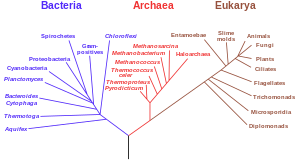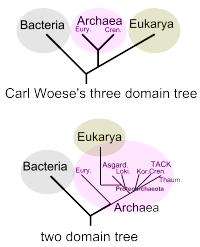
In biological taxonomy, a domain (/dəˈmeɪn/ or /doʊˈmeɪn/) (Latin: regio), also dominion, superkingdom, realm, or empire, is the highest taxonomic rank of all organisms taken together. It was introduced in the three-domain system of taxonomy devised by Carl Woese, Otto Kandler and Mark Wheelis in 1990.
According to the domain system, the tree of life consists of either three domains, Archaea, Bacteria, and Eukarya, or two domains, Archaea and Bacteria, with Eukarya included in Archaea. In the three-domain model, the first two are prokaryotes, single-celled microorganisms without a membrane-bound nucleus. All organisms that have a cell nucleus and other membrane-bound organelles are included in Eukarya and called eukaryotes.
Non-cellular life, most notably the viruses, is not included in this system. Alternatives to the three-domain system include the earlier two-empire system (with the empires Prokaryota and Eukaryota), and the eocyte hypothesis (with two domains of Bacteria and Archaea, with Eukarya included as a branch of Archaea).
Terminology
The term domain was proposed by Carl Woese, Otto Kandler, and Mark Wheelis (1990) in a three-domain system. This term represents a synonym for the category of dominion (Lat. dominium), introduced by Moore in 1974.
Development of the domain system
Carl Linnaeus made the classification "domain" popular in the famous taxonomy system he created in the middle of the eighteenth century. This system was further improved by the studies of Charles Darwin later on but could not classify bacteria easily, as they have very few observable features to compare to the other domains.
Carl Woese made a revolutionary breakthrough when, in 1977, he compared the nucleotide sequences of the 16s ribosomal RNA and discovered that the rank "domain" contained three branches, not two as scientists had previously thought. Initially, due to their physical similarities, Archaea and Bacteria were classified together and called "archaebacteria". However, scientists now know that these two domains are hardly similar and are internally distinctly different.
Characteristics of the three domains



Each of these three domains contains unique ribosomal RNA. This forms the basis of the three-domain system. While the presence of a nuclear membrane differentiates the Eukarya from the Archaea and Bacteria, both of which lack a nuclear envelope, the Archaea and Bacteria are distinct from each other due to differences in the biochemistry of their cell membranes and RNA markers.
Archaea
Further information: ArchaeaArchaea are prokaryotic cells, typically characterized by membrane lipids that are branched hydrocarbon chains attached to glycerol by ether linkages. The presence of these ether linkages in Archaea adds to their ability to withstand extreme temperatures and highly acidic conditions, but many archaea live in mild environments. Halophiles (organisms that thrive in highly salty environments) and hyperthermophiles (organisms that thrive in extremely hot environments) are examples of Archaea.
Archaea evolved many cell sizes, but all are relatively small. Their size ranges from 0.1 μm to 15 μm diameter and up to 200 μm long. They are about the size of bacteria, or similar in size to the mitochondria found in eukaryotic cells. Members of the genus Thermoplasma are the smallest of the Archaea.
Bacteria
Further information: BacteriaCyanobacteria and mycoplasmas are two examples of bacteria. Even though bacteria are prokaryotic cells just like Archaea, their cell membranes are instead made of phospholipid bilayers. Bacteria cell membranes are distinct from Archean membranes: They characteristically have none of the ether linkages that Archaea have. Internally, bacteria have different RNA structures in their ribosomes, hence they are grouped into a different category. In the two- and three-domain systems, this puts them into a separate domain.
There is a great deal of diversity in the domain Bacteria. That diversity is further confounded by the exchange of genes between different bacterial lineages. The occurrence of duplicate genes between otherwise distantly-related bacteria makes it nearly impossible to distinguish bacterial species, count the bacterial species on the Earth, or organize them into a tree-like structure (unless the structure includes cross-connections between branches, making it a "network" instead of a "tree").
Eukarya
Further information: EukaryoteMembers of the domain Eukarya – called eukaryotes – have membrane-bound organelles (including a nucleus containing genetic material) and are represented by five kingdoms: Plantae, Protozoa, Animalia, Chromista, and Fungi.
Exclusion of viruses and prions
Main article: Non-cellular life Further information: Virus and PrionThe three-domain system includes no form of non-cellular life. Stefan Luketa proposed a five-dominion system in 2012, adding Prionobiota (acellular and without nucleic acid) and Virusobiota (acellular but with nucleic acid) to the traditional three domains.
Alternative classifications
| Taxonomical root node | Two superdomains (controversial) | Two empires | Three domains | Five Dominiums | Five kingdoms | Six kingdoms | Eocyte hypothesis |
|---|---|---|---|---|---|---|---|
| Biota / Vitae / Life | Acytota / Aphanobionta non-cellular life |
Virusobiota (Viruses, Viroids) | |||||
| Prionobiota (Prions) | |||||||
| Cytota cellular life |
Prokaryota / Procarya (Monera) |
Bacteria | Bacteria | Monera | Eubacteria | Bacteria | |
| Archaea | Archaea | Archaebacteria | Archaea including eukaryotes | ||||
| Eukaryota / Eukarya | Protista | ||||||
| Fungi | |||||||
| Plantae | |||||||
| Animalia | |||||||
Alternative classifications of life include:
- The two-empire system or superdomain system, proposed by Mayr (1998), with top-level groupings of Prokaryota (or Monera) and Eukaryota.
- The eocyte hypothesis, proposed by Lake et al. (1984), which posits two domains, Bacteria and Archaea, with Eukaryota included as a subordinate clade branching from Archaea.
See also
- Biological dark matter
- Neomura, which is the two domains of life of Archaea and Eukaryota
- Phylogenetics
- Protein structure
- Realm (virology), an equivalent rank for non-cellular life
- Systematics
References
- ^ Woese C, Kandler O, Wheelis M (1990). "Towards a natural system of organisms: Proposal for the domains Archaea, Bacteria, and Eucarya". Proc Natl Acad Sci USA. 87 (12): 4576–4579. Bibcode:1990PNAS...87.4576W. doi:10.1073/pnas.87.12.4576. PMC 54159. PMID 2112744.
- ^ Moore R.T. (1974). "Proposal for the recognition of super ranks" (PDF). Taxon. 23 (4): 650–652. doi:10.2307/1218807. JSTOR 1218807.
- Nobs, Stephanie-Jane; MacLeod, Fraser I.; Wong, Hon Lun; Burns, Brendan P. (2022). "Eukarya the chimera: Eukaryotes, a secondary innovation of the two domains of life?". Trends in Microbiology. 30 (5): 421–431. doi:10.1016/j.tim.2021.11.003. PMID 34863611. S2CID 244823103.
- Doolittle, W. Ford (2020). "Evolution: Two domains of life or three?". Current Biology. 30 (4): R177 – R179. doi:10.1016/j.cub.2020.01.010. PMID 32097647.
- "Domains of Life, Genomics | Learn Science at Scitable". www.nature.com. Retrieved 1 December 2022.
- "Taxonomy I | Biology". Visionlearning. Retrieved 1 December 2022.
- Cox, C.J.; Foster, P.G.; Hirt, R.P.; Harris, S.R.; Embley, T.M. (2008). "The archaebacterial origin of eukaryotes". Proc Natl Acad Sci USA. 105 (51): 20356–61. Bibcode:2008PNAS..10520356C. doi:10.1073/pnas.0810647105. PMC 2629343. PMID 19073919.
- Ciccarelli FD, Doerks T, von Mering C, Creevey CJ, Snel B, Bork P (2006). "Toward automatic reconstruction of a highly resolved tree of life" (PDF). Science. 311 (5765): 1283–7. Bibcode:2006Sci...311.1283C. CiteSeerX 10.1.1.381.9514. doi:10.1126/science.1123061. PMID 16513982. S2CID 1615592.
- Luketa S. (2012). "New views on the megaclassification of life" (PDF). Protistology. 7 (4): 218–237. Archived from the original (PDF) on 2 April 2015. Retrieved 4 October 2016.
- Luketa, Stefan (2012). "New views on the megaclassification of life" (PDF). Protistology. 7 (4): 218–237.
- Mayr, E. (1998). "Two empires or three?". PNAS. 95 (17): 9720–9723. Bibcode:1998PNAS...95.9720M. doi:10.1073/pnas.95.17.9720. PMC 33883. PMID 9707542.
- Cavalier-Smith, T. (2004). "Only six kingdoms of life" (PDF). Proc. R. Soc. Lond. B. 271 (1545): 1251–1262. doi:10.1098/rspb.2004.2705. PMC 1691724. PMID 15306349. Retrieved 29 April 2010.
- ^ Lake, J.A.; Henderson, Eric; Oakes, Melanie; Clark, Michael W. (June 1984). "Eocytes: A new ribosome structure indicates a kingdom with a close relationship to eukaryotes". PNAS. 81 (12): 3786–3790. Bibcode:1984PNAS...81.3786L. doi:10.1073/pnas.81.12.3786. PMC 345305. PMID 6587394.
- Archibald, John M. (23 December 2008). "The eocyte hypothesis and the origin of eukaryotic cells". PNAS. 105 (51): 20049–20050. Bibcode:2008PNAS..10520049A. doi:10.1073/pnas.0811118106. PMC 2629348. PMID 19091952.
- Williams, Tom A.; Foster, Peter G.; Cox, Cymon J.; Embley, T. Martin (December 2013). "An archaeal origin of eukaryotes supports only two primary domains of life". Nature. 504 (7479): 231–236. Bibcode:2013Natur.504..231W. doi:10.1038/nature12779. PMID 24336283. S2CID 4461775.
External links
| Taxonomic ranks | ||||||||||
|---|---|---|---|---|---|---|---|---|---|---|
|
| ||||||||||